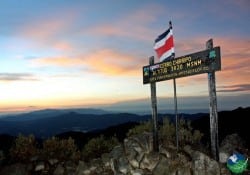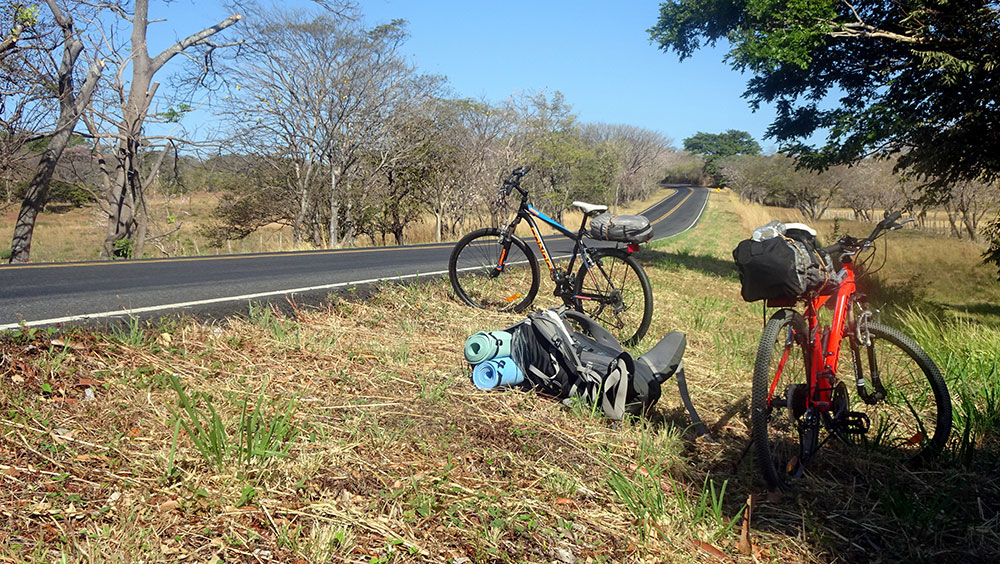A backpacker is often equated with a vagabond. Wandering with intentional simplicity and only bringing whatever can fit in one backpack. I have backpacked through countries is Asia, Latin America and Europe and every country poses its own challenges for the travelers looking to keep it cheap, safe and enjoyable as well as independent.
When comparing Costa Rica to other countries I have visited, keeping it cheap was the biggest challenge. It is perfectly possible if you choose to cook for yourself and know where to get your groceries cheaply and if not, choose to visit local sodas. Additionally, you could either camp or stay in hostels and you can visit some off the beaten path places that have a lower entrance fee, if they even have one at all.
This article offers you an insight into some of Costa Rica’s more remote destinations as well as the best hostels at the popular tourist hotspots. Discover alternative methods of travel by rethinking how and where you would like to spend the night. There are more options than just a hostel and a tent!
You will receive a long list practical tips and also get some guidance in how to make your backpacking trip more sustainable.
Welcome to the ultimate guide to backpacking in Costa Rica!

Costa Rica's more remote destinations
If you are reading this, you are probably already familiar with Costa Rica most popular destination such as Monteverde, Manuel Antonio and Arenal. But what about those destinations that generally don’t make the list? Here are a couple to inspire the real off the beaten path travelers amongst you.

Playa Naranjo is often ignored in favor of more popular and more accessible beaches in Guanacaste, but there are few that are this beautiful. This trip is especially interesting for mountain bikers looking for a challenge. The first part after the park entrance is paved, but the last 8k is a real off the road experience with a gravely dirt road that goes straight down. If you are driving, only a 4-wheel drive will do. Since Playa Naranjo is located in a national park, there will be no amenities other than camping grounds and some outdoor showers and a couple of barbecue fixtures. This beach is especially famous amongst advanced surfers. Read my blog about visiting Santa Rosa National parks with a mountain bike for more information.
 Chirripo has the honor of being the tallest mountain of Costa Rica. With its 3,821 meters, it is a fair challenge for those looking to push their limits a bit. The name Chirripo was given by the Native Americans and translates as Land of Eternal Waters. While the physical challenge is already worth the trip, the best part is the incredible biodiversity.
Chirripo has the honor of being the tallest mountain of Costa Rica. With its 3,821 meters, it is a fair challenge for those looking to push their limits a bit. The name Chirripo was given by the Native Americans and translates as Land of Eternal Waters. While the physical challenge is already worth the trip, the best part is the incredible biodiversity.
The hike starts at around 1500 meters above sea level close to the birding haven of San Gerardo. Initially, you pass through pastures, woodlands and fields. Soon you will be experiencing the first radical change of scenery as you head through a lush rainforest. The higher you get, the more the lush trees turn into drier shrubland, culminating in a tundra-like climate near the top.
If you plan on hiking Chirripo, you have to make sure to purchase a permit beforehand.
 This is a great hiking trip for those wanting to combine convenience with an off the road experience. The Miravalles volcano is located at a mere 60 kilometers from Liberia and is one of the giants towering over Guanacaste’s capital. To get to the entrance of the trail, you only need to take one public bus (Liberia – Guayabo) until you reach the town of Guayabal.
This is a great hiking trip for those wanting to combine convenience with an off the road experience. The Miravalles volcano is located at a mere 60 kilometers from Liberia and is one of the giants towering over Guanacaste’s capital. To get to the entrance of the trail, you only need to take one public bus (Liberia – Guayabo) until you reach the town of Guayabal.
This is where Freddy Soto Miranda lives and his house is right next to one of the most remote trails to the summit. You pay him a minor fee to use his land and if you like, he can also do the hike with you. It will take you between 8-9 hours to head up and back down. Keep in mind that Freddy only speaks Spanish!
 From the dry and hot Guanacaste to the sultry Caribbean. There are several destinations here worth visiting including Tortuguero, Cahuita and Puerto Viejo, but the Gandoca Manzanillo Wildlife Refuge gives off that extra bit of Caribbean charm.
From the dry and hot Guanacaste to the sultry Caribbean. There are several destinations here worth visiting including Tortuguero, Cahuita and Puerto Viejo, but the Gandoca Manzanillo Wildlife Refuge gives off that extra bit of Caribbean charm.
This refuge was quite literally off the road until a paved road was introduced in 2003. Even then, this part of Costa Rica’s Atlantic received less attention than its more famous neighbors.
Manazanillo was declare a Refugio back in 1985, which beautifully frames its pristine qualities to this day. The most popular activities in this area are snorkeling, kayaking and hiking.
 Like Manzanillo this is certainly not a completely unknown destination, but it is one of the most remote destinations in Costa Rica. As part of the Osa Peninsula, this tiny region in Costa Rica has been voted the most biologically intense place in the world.
Like Manzanillo this is certainly not a completely unknown destination, but it is one of the most remote destinations in Costa Rica. As part of the Osa Peninsula, this tiny region in Costa Rica has been voted the most biologically intense place in the world.
This national park hosts an incredible amount of wildlife species including all 4 monkey species to be found in Costa Rica as well as all 6 felines. 100 species of butterflies, no less than 10.000 insect species, peccaries, crocodiles, more than 400 species of birds including scarlet macaws, the list goes on. This is a destination reserved for the real nature lovers who just need their backpack and one of the most beautiful places on the planet.
Do you want to avoid big touring agencies but want a more authentic experience with a little guidance? Then read this blog on organizing your hikes to more remote destinations with smaller, local agencies!
Hostels in Costa Rica
When we think backpacking, we automatically think hostels. Costa Rica may seem like a pretty high-end travel destination with its fancy resorts and all-inclusive packages, but there are a number of great hostels available for the budget travelers. Generally speaking, a bed in a dorm starts at 10 USD including breakfast or the use of a communal kitchen. Check out this list of amazing hostels at some of Costa Rica’s most popular destinations.
| San Jose
|
The Garden Costa Rica
Bed in a dorm from 15 USD
|
Monteverde
|
Hostel Monteverde Backpackers
Bed in a dorm from 10 USD
Breakfast included
|
| Liberia
|
Hospedaje Dodero
Bed in a dorm from 10 USD
|
Tamarindo
|
Casa Aura
Bed in a dorm from 20 USD
Breakfast included
|
| Osa Peninsula
|
Utopia Tica Sustainable Lodge
Bed in a dorm from 10 USD
|
Santa Teresa
|
Hostel Dos Monos South
Bed in a dorm from 12 USD
Breakfast included
|
| Arenal
|
Arenal Backpackers Resort
Bed in a dorm from 15 USD
|
Jaco
|
Hostel de Haan
Bed in a dorm from 10 USD
|
| Manuel Antonio
|
Hostel Plinio
Bed in a dorm from 12 USD
Breakfast included
|
Puerto Viejo
|
Madre Selva Hostel
Bed in a dorm from 10 USD
|
All of these hostels also have private rooms. This can be a good choice if you are traveling as a couple since it will often come to a similar price when splitting the room rate amongst the two of you.
If you want to find the perfect hostels, the best place to look are Hostelworld and Booking.com. Hostelworld tends to have better deals and also features various hostels you can’t find on Booking.com!
Selina Hostels – A haven for digital nomads and community-minded travelers
The Selina Hostels are popping up like mushrooms. They describe themselves as a lifestyle rather than just another chain of hostels. Selina is tapping into the subculture of digital nomads by providing excellent work spaces and a stable internet connection for those who wish to travel and work indefinitely.
Next to that, Selina also wants to give back to the community and invites its guests to volunteer and contribute while they travel, strengthening a community amongst travelers as well as locals.
Still growing, Selina Costa Rica currently has hostels in:
Jaco
La Fortuna
Manuel Antonio
Nosara
Puerto Viejo
San Jose
Santa Teresa (north and south)
Tamarindo
 Selina Hostel in Puerto Viejo
Selina Hostel in Puerto Viejo
Travel differently
Looking for something a little bit more different than a hostel? Then you are sure to find these next 4 suggestions very interesting.
Couchsurfing
Couchsurfing is a great way to get a more authentic experience out of your travels ‘and’ get a free bed in the process. Locals passionate about sharing their culture, offer you a bed (or couch) in their home and show you some of their favorite spots in the area. It is a great chance for cultural exchange and seeing Costa Rica through a local’s eyes.
Workaway
This is one of my favorite ways of traveling. For a minor annual fee, you can register for Workaway and find work opportunities (unpaid but all expenses included) in practically every sector. Whether you would like to work with local wildlife, sustainable farming, teaching, culture, hospitality, … You are bound to find a job that interests you.
Housesitting
If you want to help fellow-travelers out, house sitting is a great way to get to know a country in a more intimate way as well as get a free stay (although you do have to pay a sitter membership). Create an account with Trusted House Sitters and find houses in the area you want to visit. Most people offering up their home will do so with the main purpose of having you look after their pets or even their farm while they are away.
Volunteering
Ideally, volunteering will amount to mutual benefit. The traveler will learn more about the country he is traveling to and get a better insight into the social and or environmental problems communities face, and the local communities will benefit from the support. The most popular volunteer programs in Costa Rica include working with animals, planting trees, beach cleanups and teaching. Organizations of some note include:
Corcovado Foundation
Kids Saving the Rainforest
Costa Rica Rescue Center
Costa Rica Humanitarian Foundation
Practical tips
When to visit
Costa Rica has a dry season from December until May and a rainy season the rest of the year. That being said, both seasons are a good time to travel. During rainy season, the prices will drop drastically and there will be far less tourists. It is also important to note that most showers will be in the afternoon, leaving the morning for hikes and other activities. Consult our weather article for more pros and cons!
Safety
Costa Rica is safe for travelers. The biggest problem is theft and mugging so the most important thing is to make sure that you keep valuable possessions out of view and out of reach (think travel belt under your clothes). For a complete list of safety tips, consult our safety article.
Eating cheaply
Keep it cheap by booking a hostel with a shared kitchen and going to the grocery store or farmer’s market. The cheapest supermarkets are Pali and Maxipali. You will also encounter cheap and small family-run ‘tiendas’ locals refer to as Chinos, since they are often run by Chinese families.
Supermarkets with an average to high price range that are also widely available are Mega Super and Perimercado.
The supermarket with a range of imported products and an average price range is MasxMenos. Automercado also has a large imported selection but is more expensive. You will also find the occasional Wall-Mart.
If you feel like eating out but don’t want to overpay at a touristy restaurant, visit a local soda. These are small restaurants open for breakfast and lunch but sometimes also for dinner. This is a great place to try local dishes like gallo pinto and a casado for a low price.
Read about some extra tips if you are a vegetarian traveling to Costa Rica and a list of farmers markets.
Backpacker packing list
My advice is to bring as little clothes as possible and keep it simple. Focus on fast-drying materials if you can and keep the colors neutral. Depending on what you do, bring only 1 or 2 sets for every type of weather from the blistering Guanacaste sun to the sometimes-chilly Central Valley.
Other than clothes and obvious items such as your toothbrush, I recommend you take these items with you:
Your backpack:
I will always swear by Deuter Aircontact as the best one out there. It is very comfortable and definitely worth the money. Mine has been with me through a lot of adventures and is still completely intact.
Foldable day-bag:
This saves a lot of room and also means you don’t force yourself to carry two bags all the time. A lot of these day bags are also waterproof.
Waterproof trekking shoes, sneakers and flip-flops:
This way you can be prepared for hiking, wandering through cities and relaxing beach and hostel time.
Dry bag:
When wading through rivers or traveling in rainy weather, you will definitely want to protect your electronics.
Tent, sleeping bag and sleeping mat:
If you plan on camping, obviously. Despite the tropical climate, the nights can get pretty cold in higher regions. It might also be a good idea to invest in a mosquito net.
Bug repellent:
This is essential in Costa Rica. Most products with a high level in DEET come highly recommended but there are also more natural alternatives. Read our article on mosquitoes to learn more.
Mesh laundry bag:
This is a good item if you are keen on separating your dirty laundry. If you would rather not invest in a laundry bag, you can also bring a pillow case. The important thing, is that the bag you use is made of breathable material.
Indestructible sunglasses:
Don’t cheap out on your sunglasses, especially if you love hiking.
Flashlight / head torch:
Power cuts are not unusual in Costa Rica. If you plan on camping, a head torch might be extra handy.
Emergency sewing kit:
Easily forgotten but almost always needed.
Fast-drying microfiber towel:
They generally come in a handy little bag that compresses them and they will be dry overnight. A backpacker must-have.
Hat for sun protection and factor 50 sun block:
The sun can get pretty intense in Costa Rica so these are absolutely essential.
Rain poncho:
Whether you are traveling during the dry season or the rainy season, a reusable rain poncho that folds into a tiny bundle will take up very little room and could be very useful in certain national parks like cloud forests. If you want to spot wildlife, try to get one in a neutral color since most of these ponchos are pretty flashy.
Water bottle:
Water in Costa Rica is safe to drink. Limit your use of plastic and fill your water bottle as often as you can.
Travel belt:
I always use a travel belt under my clothes to protect value bales such as my passport and emergency money.
Portable charger:
This has become quite essential in the digital age. Look into the ones that have solar chargers as well as electrical ones.
Biodegradable soap:
Whether it is for your clothes, dishes or yourself, biodegradable soap is a worthy investment, especially if you plan on camping.

Travel responsibly
Backpacking is a good opportunity to travel simply and responsibly. You will already be avoiding big resorts and wasteful luxuries, so this is your chance to take it further.
Ban the plastic bottle
Tap water is safe to drink in Costa Rica and rather than quickly grabbing that bottle of water in the store, take a reusable bottle with you.
Treat locals and animals with respect
Be respectful when taking photos of locals and ask permission first. When photographing wildlife, do so while they remain in their natural habitat and don’t disturb their routine by removing them from it or getting too close to take a selfie. Also take care to never feed the animals.
Plant trees and support conservation efforts
There are a lot of local organizations that promote conservation and sustainability. Kids Saving the Rainforest, for example, famously protects sloths and plants trees near Manual Antonio while The Corcovado Foundation protects the endangered sea turtles and the biologically stunning yet fragile Osa Peninsula.
You can offset the CO2 emissions caused by your flights and other transportation by adding certain actions to you traveling routine such as planting trees. Read more about how to have a Carbon Neutral Vacation.
Support local initiatives
Other than wildlife and environmental conservation, there are also plenty of causes that support the local communities. My Costa Rica supports two such initiatives by offering much needed supplies to a local orphanage and to an education program for the less fortunate. You can help by bringing these supplies and helping to secure a better future for the local children. Read more about our Pack for a Purpose Program and other initiatives.
Despite its reputation as a luxury destination, Costa Rica is a great country for backpackers as well. There is a solid infrastructure in place to satisfy the traveler on a budget as well as those looking for something a little different. You only have to know where to look!
AUTHOR’S BIO
 Hi! My name is Mieke and I am one of the My Costa Rica writers/editors! I am originally from Belgium but after traveling for about a year, I decided to settle here in Costa Rica and carve out a life for myself. I have visited many countries including Nepal, Nicaragua, Bolivia, Peru, Mexico, and of course Costa Rica. Before I left for this wonderful adventure, I was a hotel Shift-Leader in Gent, Belgium. In fact, I have had a lot of different jobs from organizing events to cleaning offices but I feel with writing and editing I have discovered my true calling. Back in 2012 I received my master’s degree in Art History. Studying art has made me appreciate cultural diversity and expression which I have been able to build on greatly during my travels and now for my job!
Hi! My name is Mieke and I am one of the My Costa Rica writers/editors! I am originally from Belgium but after traveling for about a year, I decided to settle here in Costa Rica and carve out a life for myself. I have visited many countries including Nepal, Nicaragua, Bolivia, Peru, Mexico, and of course Costa Rica. Before I left for this wonderful adventure, I was a hotel Shift-Leader in Gent, Belgium. In fact, I have had a lot of different jobs from organizing events to cleaning offices but I feel with writing and editing I have discovered my true calling. Back in 2012 I received my master’s degree in Art History. Studying art has made me appreciate cultural diversity and expression which I have been able to build on greatly during my travels and now for my job!
Home » Costa Rica Travel » My Costa Rica Travel Blog » Backpacking in Costa Rica



 Chirripo has the honor of being the tallest mountain of Costa Rica. With its 3,821 meters, it is a fair challenge for those looking to push their limits a bit. The name Chirripo was given by the Native Americans and translates as Land of Eternal Waters. While the physical challenge is already worth the trip, the best part is the incredible biodiversity.
Chirripo has the honor of being the tallest mountain of Costa Rica. With its 3,821 meters, it is a fair challenge for those looking to push their limits a bit. The name Chirripo was given by the Native Americans and translates as Land of Eternal Waters. While the physical challenge is already worth the trip, the best part is the incredible biodiversity. This is a great hiking trip for those wanting to combine convenience with an off the road experience. The Miravalles volcano is located at a mere 60 kilometers from Liberia and is one of the giants towering over Guanacaste’s capital. To get to the entrance of the trail, you only need to take one public bus (Liberia – Guayabo) until you reach the town of Guayabal.
This is a great hiking trip for those wanting to combine convenience with an off the road experience. The Miravalles volcano is located at a mere 60 kilometers from Liberia and is one of the giants towering over Guanacaste’s capital. To get to the entrance of the trail, you only need to take one public bus (Liberia – Guayabo) until you reach the town of Guayabal. From the dry and hot Guanacaste to the sultry Caribbean. There are several destinations here worth visiting including Tortuguero, Cahuita and Puerto Viejo, but the Gandoca Manzanillo Wildlife Refuge gives off that extra bit of Caribbean charm.
From the dry and hot Guanacaste to the sultry Caribbean. There are several destinations here worth visiting including Tortuguero, Cahuita and Puerto Viejo, but the Gandoca Manzanillo Wildlife Refuge gives off that extra bit of Caribbean charm. Like Manzanillo this is certainly not a completely unknown destination, but it is one of the most remote destinations in Costa Rica. As part of the Osa Peninsula, this tiny region in Costa Rica has been voted the most biologically intense place in the world.
Like Manzanillo this is certainly not a completely unknown destination, but it is one of the most remote destinations in Costa Rica. As part of the Osa Peninsula, this tiny region in Costa Rica has been voted the most biologically intense place in the world.




 Hi! My name is Mieke and I am one of the My Costa Rica writers/editors! I am originally from Belgium but after traveling for about a year, I decided to settle here in Costa Rica and carve out a life for myself. I have visited many countries including Nepal, Nicaragua, Bolivia, Peru, Mexico, and of course Costa Rica. Before I left for this wonderful adventure, I was a hotel Shift-Leader in Gent, Belgium. In fact, I have had a lot of different jobs from organizing events to cleaning offices but I feel with writing and editing I have discovered my true calling. Back in 2012 I received my master’s degree in Art History. Studying art has made me appreciate cultural diversity and expression which I have been able to build on greatly during my travels and now for my job!
Hi! My name is Mieke and I am one of the My Costa Rica writers/editors! I am originally from Belgium but after traveling for about a year, I decided to settle here in Costa Rica and carve out a life for myself. I have visited many countries including Nepal, Nicaragua, Bolivia, Peru, Mexico, and of course Costa Rica. Before I left for this wonderful adventure, I was a hotel Shift-Leader in Gent, Belgium. In fact, I have had a lot of different jobs from organizing events to cleaning offices but I feel with writing and editing I have discovered my true calling. Back in 2012 I received my master’s degree in Art History. Studying art has made me appreciate cultural diversity and expression which I have been able to build on greatly during my travels and now for my job!





Follow Us